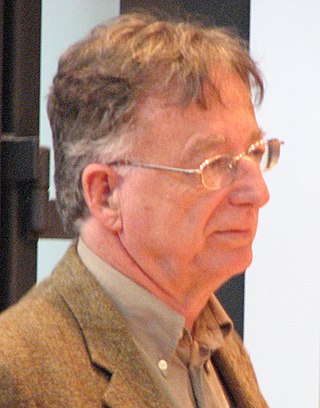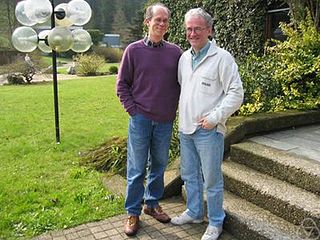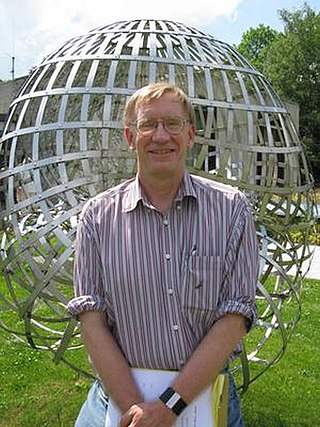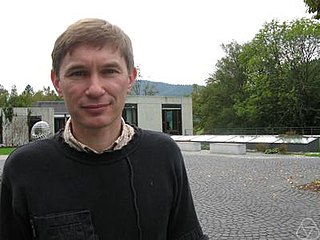
Algebraic topology is a branch of mathematics that uses tools from abstract algebra to study topological spaces. The basic goal is to find algebraic invariants that classify topological spaces up to homeomorphism, though usually most classify up to homotopy equivalence.
Daniel Gray "Dan" Quillen was an American mathematician. He is known for being the "prime architect" of higher algebraic K-theory, for which he was awarded the Cole Prize in 1975 and the Fields Medal in 1978.
In gauge theory and mathematical physics, a topological quantum field theory is a quantum field theory which computes topological invariants.
Algebraic K-theory is a subject area in mathematics with connections to geometry, topology, ring theory, and number theory. Geometric, algebraic, and arithmetic objects are assigned objects called K-groups. These are groups in the sense of abstract algebra. They contain detailed information about the original object but are notoriously difficult to compute; for example, an important outstanding problem is to compute the K-groups of the integers.

Sergei Petrovich Novikov is a Soviet and Russian mathematician, noted for work in both algebraic topology and soliton theory. In 1970, he won the Fields Medal.
In mathematics, Khovanov homology is an oriented link invariant that arises as the cohomology of a cochain complex. It may be regarded as a categorification of the Jones polynomial.
In mathematics, Floer homology is a tool for studying symplectic geometry and low-dimensional topology. Floer homology is a novel invariant that arises as an infinite-dimensional analogue of finite-dimensional Morse homology. Andreas Floer introduced the first version of Floer homology, now called Lagrangian Floer homology, in his proof of the Arnold conjecture in symplectic geometry. Floer also developed a closely related theory for Lagrangian submanifolds of a symplectic manifold. A third construction, also due to Floer, associates homology groups to closed three-dimensional manifolds using the Yang–Mills functional. These constructions and their descendants play a fundamental role in current investigations into the topology of symplectic and contact manifolds as well as (smooth) three- and four-dimensional manifolds.

In algebraic topology, the Massey product is a cohomology operation of higher order introduced in, which generalizes the cup product. The Massey product was created by William S. Massey, an American algebraic topologist.

Dennis Parnell Sullivan is an American mathematician known for his work in algebraic topology, geometric topology, and dynamical systems. He holds the Albert Einstein Chair at the City University of New York Graduate Center and is a distinguished professor at Stony Brook University.
In knot theory, an area of mathematics, the link group of a link is an analog of the knot group of a knot. They were described by John Milnor in his Ph.D. thesis,. Notably, the link group is not in general the fundamental group of the link complement.

Ronald Brown is an English mathematician. Emeritus Professor in the School of Computer Science at Bangor University, he has authored many books and more than 160 journal articles.
String topology, a branch of mathematics, is the study of algebraic structures on the homology of free loop spaces. The field was started by Moira Chas and Dennis Sullivan (1999).

Fabien Morel is a French algebraic geometer and key developer of A¹ homotopy theory with Vladimir Voevodsky. Among his accomplishments is the proof of the Friedlander conjecture, and the proof of the complex case of the Milnor conjecture stated in Milnor's 1983 paper 'On the homology of Lie groups made discrete'. This result was presented at the Second Abel Conference, held in January–February 2012.

Gunnar E. Carlsson is an American mathematician, working in algebraic topology. He is known for his work on the Segal conjecture, and for his work on applied algebraic topology, especially topological data analysis. He is a Professor Emeritus in the Department of Mathematics at Stanford University. He is the founder and president of the predictive technology company Ayasdi.
In algebraic K-theory, the K-theory of a categoryC (usually equipped with some kind of additional data) is a sequence of abelian groups Ki(C) associated to it. If C is an abelian category, there is no need for extra data, but in general it only makes sense to speak of K-theory after specifying on C a structure of an exact category, or of a Waldhausen category, or of a dg-category, or possibly some other variants. Thus, there are several constructions of those groups, corresponding to various kinds of structures put on C. Traditionally, the K-theory of C is defined to be the result of a suitable construction, but in some contexts there are more conceptual definitions. For instance, the K-theory is a 'universal additive invariant' of dg-categories and small stable ∞-categories.
Ernesto Lupercio is a Mexican mathematician. He was awarded the ICTP Ramanujan Prize in 2009, "for his outstanding contributions to algebraic topology, geometry and mathematical physics."
Richard James Milgram is an American mathematician, specializing in algebraic topology. He is the son of mathematician Arthur Milgram.
Aldridge Knight Bousfield, known as "Pete", was an American mathematician working in algebraic topology, known for the concept of Bousfield localization.

Alexander A. Voronov is a Russian-American mathematician specializing in mathematical physics, algebraic topology, and algebraic geometry. He is currently a Professor of Mathematics at the University of Minnesota and a Visiting Senior Scientist at the Kavli Institute for the Physics and Mathematics of the Universe.
Frederick Ronald Cohen was an American mathematician working in algebraic topology.











